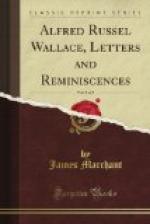My dear Violet,— ... I have found a doctor at Poole (Mr. Turner) who has two nice orchid houses which he attends to entirely himself, and as I can thus get advice and sympathy from a fellow maniac (though he is a public vaccinator!) my love of orchids is again aroused to fever-heat, and I have made some alterations in the greenhouse which will better adapt it for orchid growing, and have bought a few handsome kinds very cheap, and these give me a lot of extra work and amusement....
* * * * *
TO HIS WIFE
Hotel du Glacier du Rhone. Wednesday evening, [July, 1895].
My dear Annie,—I send you now a box of plants I got on both sides of the Furka Pass yesterday, and about here to-day. The Furka Pass on both sides is a perfect flower-garden, and the two sides have mostly different species. The violets and anemones were lovely, and I have got two species of glorious gentians.... All the flowers in the box are very choice species, and have been carefully dug up, and having seen how they grow, I have been thinking of a plan of making a little bed for them on the top of the new rockery where there is now nothing particular. Will you please plant them out carefully in the zinc tray of peat and sphagnum that stands outside near the little greenhouse door? Just lift up the sphagnum and see if the earth beneath is moist, if not give it a soaking. Then put them all in, the short-rooted ones in the sphagnum only, the others through into the peat. Then give them a good syringing and put the tray under the shelf outside the greenhouse, and cover with newspaper for a day or two. After that I think they will do, keeping them moist if the weather is dry. I am getting hosts of curiosities. To-day we found four or five species of willows from 1/4 in. to 2 in. high, and other rarities.... In haste for post and dinner.—Your ever affectionate
ALFRED R. WALLACE.
* * * * *
TO MISS VIOLET WALLACE
Parkstone, Dorset. October 22, 1897.
My dear Violet,—In your previous letter you asked me the conundrum, Why does a wagtail wag its tail? That’s quite easy, on Darwinian principles. Many birds wag their tails. Some Eastern flycatchers—also black and white—wag their long tails up and down when they alight on the ground or on a branch. Other birds with long tails jerk them up in the air when they alight on a branch. Now these varied motions, like the motions of many butterflies, caterpillars, and many other animals, must have a use to the animal, and the most common, or rather the most probable, use is, either to frighten or to distract an enemy. If a hawk was very hungry and darted down on a wagtail from up in the air, the wagging tail would be seen most distinctly and be aimed at, and thus the bird would be missed or at most a feather torn out of the tail. The bird hunts for food in the open, on the edges of ponds and streams, and would be especially easy to capture, hence the wagging tail has been developed to baffle the enemy....




